
Concept explainers
(a)
Interpretation:
The IUPAC name of the given molecule is to be written.
Concept introduction:
The root name of the molecule is the name of the
Answer to Problem A.45P
The IUPAC name of the given molecule is
Explanation of Solution
The given molecule is:

In this molecule, the six carbons ring act as a parent. Hence, the root is cyclohexane. The ring has two substituents

The ring is numbered in a way that the carbon to which the
Hence, the IUPAC name is
The IUPAC name of the given molecule is written as
(b)
Interpretation:
The IUPAC name of the given molecule is to be written.
Concept introduction:
The root name of the molecule is the name of the alkane which depends on the longest continuous chain of carbon atoms. The name of the substituent attached to the parent chain is written as a prefix to the left side of the root. The chain is numbered such that the carbon atom to which the substituent is attached, gets the lowest possible number. This number is written on the left side of the substituent and separated by a hyphen. If more than one substituent is present, then the numbering is determined by the alphabetical order of substituents.
Answer to Problem A.45P
The IUPAC name of the given molecule is
Explanation of Solution
The given molecule is:
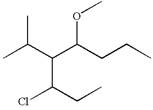
In this molecule, the longest continuous chain of carbon atoms has eight carbon atoms. Hence, the root is octane.
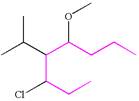
The parent chain has three substituents, thus the chain is numbered so as to provide the lowest set of locants.
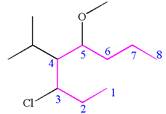
Hence, the IUPAC name is
The IUPAC name of the given molecule is written as
(c)
Interpretation:
The IUPAC name of the given molecule is to be written.
Concept introduction:
The root name of the molecule is the name of the alkane which depends on the longest continuous chain of carbon atoms or the ring structure. The name of the substituent attached to the parent chain is written as a prefix to the left side of the root.
Answer to Problem A.45P
The IUPAC name of the given molecule is
Explanation of Solution
The given molecule is:
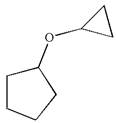
In this molecule, the five carbons ring is a parent. Hence, the root is cyclopentane. Since the ring has only one substituent, there is no need to number the ring to decide the position of the substituent.
Hence, the IUPAC name is
The IUPAC name of the given molecule is written as
(d)
Interpretation:
The IUPAC name of the given molecule is to be written.
Concept introduction:
The root name of the molecule is the name of the alkane which depends on the longest continuous chain of carbon atoms or the ring structure. The name of the substituent attached to the parent ring is written as a prefix to the left side of the root. The parent ring is numbered such that the carbon atom to which the substituent is attached, gets the lowest possible number. This number is written on the left side of the substituent and separated by a hyphen. If more than one substituent is present, then the numbering is determined by the alphabetical order of substituents.
Answer to Problem A.45P
The IUPAC name of the given molecule is
Explanation of Solution
The given molecule is:
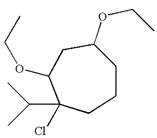
In this molecule, the seven carbons ring is a parent. Hence, the root is cycloheptane. The ring has four substituents, thus the ring is numbered so as to provide the lowest set of locants.
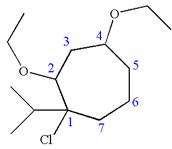
Hence, the IUPAC name is
The IUPAC name of the given molecule is written as
(e)
Interpretation:
The IUPAC name of the given molecule is to be written.
Concept introduction:
The root name of the molecule is the name of the alkane which depends on the longest continuous chain of carbon atoms. The name of the substituent attached to the parent chain is written as a prefix to the left side of the root. The chain is numbered such that the carbon atom to which the substituent is attached, gets the lowest possible number. This number is written on the left side of the substituent and separated by a hyphen. If more than one substituent is present then the numbering is determined by the alphabetical order of substituents.
Answer to Problem A.45P
The IUPAC name of the given molecule is
Explanation of Solution
The given molecule is:
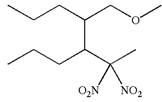
In this molecule, the longest continuous chain of carbon atoms has eight carbon atoms. Hence, the root is octane.
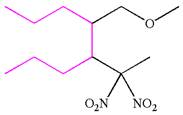
The parent chain has two substituents, thus the chain is numbered so as to provide the lowest set of locants according to alphabetical order.
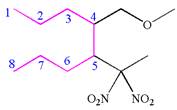
Hence, the IUPAC name is
The IUPAC name of the given molecule is written as
(f)
Interpretation:
The IUPAC name of the given molecule is to be written.
Concept introduction:
The root name of the molecule is the name of the alkane which depends on the longest continuous chain of carbon atoms or the ring structure. The name of the substituent attached to the parent ring is written as a prefix to the left side of the root. The parent ring is numbered such that the carbon atom to which the substituent is attached, gets the lowest possible number. This number is written on the left side of the substituent and separated by a hyphen. If more than one substituent present then numbering is determined by the alphabetical order of substituents in a way to provide the lowest set of locants.
Answer to Problem A.45P
The IUPAC name of the given molecule is
Explanation of Solution
The given molecule is:
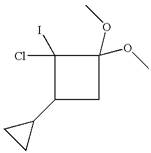
In this molecule, the four carbons ring is a parent. Hence, the root is cyclobutane. The ring has five substituents, thus the ring is numbered so as to provide the lowest set of locants.
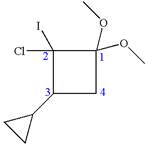
Hence, the IUPAC name is
The IUPAC name of the given molecule is written as
(g)
Interpretation:
The IUPAC name of the given molecule is to be written.
Concept introduction:
The root name of the molecule is the name of the alkane which depends on the longest continuous chain of carbon atoms or the ring structure. The name of the substituent attached to the parent ring is written as a prefix to the left side of the root. The parent ring is numbered such that the carbon atom to which the substituent is attached, gets the lowest possible number. This number is written on the left side of the substituent and separated by a hyphen. If more than one substituent is present, then the numbering is determined by the alphabetical order of substituents.
Answer to Problem A.45P
The IUPAC name of the given molecule is
Explanation of Solution
The given molecule is:
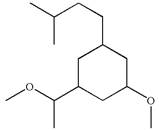
In this molecule, the six carbons ring is a parent. Hence, the root is cyclohexane. The ring has three substituents, thus the ring is numbered so as to provide the lowest set of locants.
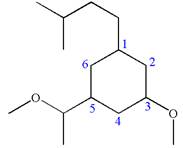
Hence, the IUPAC name is
The IUPAC name of the given molecule is written as
(h)
Interpretation:
The IUPAC name of the given molecule is to be written.
Concept introduction:
The root name of the molecule is the name of the alkane which depends on the longest continuous chain of carbon atoms. The name of the substituent attached to the parent chain is written as a prefix to the left side of the root. The chain is numbered such that the carbon atom to which the substituent is attached, gets the lowest possible number. This number is written on the left side of the substituent and separated by a hyphen. If more than one substituent is present, then the numbering is determined by the alphabetical order of substituents.
Answer to Problem A.45P
The IUPAC name of the given molecule is
Explanation of Solution
The given molecule is:

In this molecule, the longest continuous chain of carbon atoms has eight carbon atoms. Hence, the root is octane.
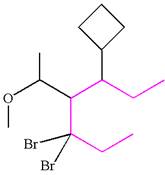
The parent chain has two substituents, thus the chain is numbered so as to provide the lowest set of locants.
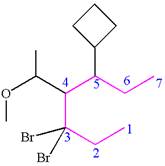
Hence, the IUPAC name is
The IUPAC name of the given molecule is written as
Want to see more full solutions like this?
Chapter A Solutions
Organic Chemistry: Principles and Mechanisms (Second Edition)
- Draw the product of the E2 reaction shown below. Include the correct stereochemistry. Ignore any inorganic byproducts. + Br CH3 Q Strong Base Drawing Atoms, Bonds and Rings Charges Undo Reset H "Br H N Br. Remove Done .N. Drag To Panarrow_forwardCurved arrows are used to illustrate the flow of electrons. Use the reaction conditions provided and follow the curved arrows to draw the product of this elementary step in an elimination mechanism. Include all lone pairs and charges as appropriate. Ignore stereochemistry. Ignore byproducts. + Br: .. 8 0.01 M NaOH heat Drawing Q Atoms, Bonds and Rings Charges and Lone Pairs Draw or tap a new bond to see suggestions. Undo Reset Remove Done + Drag To Panarrow_forward+ Draw the product of the E2 reaction shown below. Include the correct stereochemistry. Ignore any inorganic byproducts. Ph CH2CH3 H H3C H Br DBN [૪] Drawing Atoms, Bonds and Rings H | OH Charges ―00 H. C | Undo Reset Br I Remove Done Drag To Pan +arrow_forward
- Reaction A Now the production A ΠIn the product of reaction i 12 Dear the product of actionarrow_forwardMacmillan Learnin When an unknown amine reacts with an unknown acid chloride, an amide with a molecular mass of 163 g/mol (M* = 163 m/z) is formed. In the infrared spectrum, important absorptions appear at 1661, 750 and 690 cm-1. The 13C NMR and DEPT spectra are provided. Draw the structure of the product as the resonance contributor lacking any formal charges. 13C NMR DEPT 90 200 160 120 80 40 0 200 160 120 80 DEPT 135 200 160 120 80 40 0 Draw the unknown amide. 40 40 0arrow_forwardDraw the major product karmed when I reach with the epoxide. Use walge dah bonds, including hydrogen al alcach genic center, to show the chemistry of the product Beeldraw any hydrogen akams on coxygen where applicablearrow_forward
- Curved arrows are used to illustrate the flow of electrons. Using the provided starting and product structures, draw the curved electron-pushing arrows for the following reaction or mechanistic step(s). Be sure to account for all bond-breaking and bond-making steps. H I Select to Add Arrows + H H 'H Q H2O H2O CI:O .H H H H I Select to Add Arrows I : C H2O H H H Select to Add Arrows 'Harrow_forward+ Draw an alkyl halide that produces ONLY the following alkene in an E2 elimination. Ignore any inorganic byproducts. Drawing Strong Base Q Atoms, Bonds and Rings Charges HO Br H2N Undo Reset Remove Done Drag To Panarrow_forwardFor the dehydrohalogenation (E2) reaction shown, draw the major organic product. Хок Br tert-butanol heat Select Drew Templates More Erase CH QQQarrow_forward
- Macmillan Learning Draw the major, neutral organic product for each substitution reaction. For this question, assume that each substitution reaction goes to completion. Disregard elimination. Reaction A. CI H₂O Select Draw Templates More Erase C Harrow_forwardMacmillan Learning Reaction B: CI HO_ 곳으 / Select Draw Templates More с € H D Erasearrow_forwardWhen 2-bromo-93-dimethylbutane is heated with sodium methoxide, one majors.. në la formed. 4th attempt Part 1 (0.5 point) t Ji See Periodic Table See Hint Draw the major alkene product and all other byproducts. Be sure to include lone-pair electrons and charges. Part 2 (0.5 point) What type of mechanism is occuring? Choose one: AS1 3rd attempt X H 41 See Hint Part 1 (0.5 point) Feedback See Periodic Table See Hintarrow_forward
